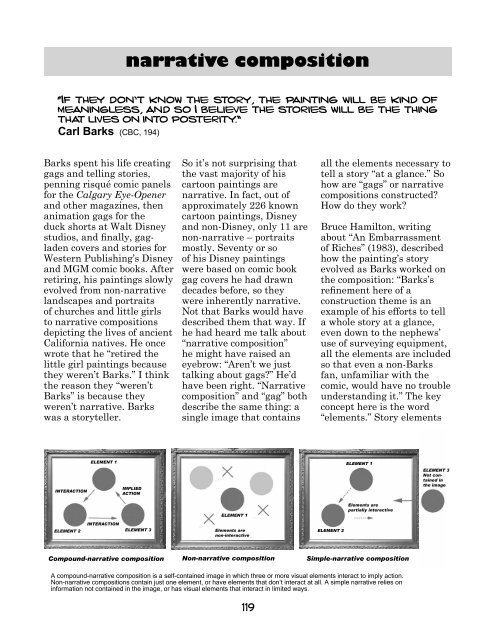Painting Fine-Art Cartoons in Oils - Enchanted Images
Painting Fine-Art Cartoons in Oils - Enchanted Images
Painting Fine-Art Cartoons in Oils - Enchanted Images
You also want an ePaper? Increase the reach of your titles
YUMPU automatically turns print PDFs into web optimized ePapers that Google loves.
Barks spent his life creat<strong>in</strong>g<br />
gags and tell<strong>in</strong>g stories,<br />
penn<strong>in</strong>g risqué comic panels<br />
for the Calgary Eye-Opener<br />
and other magaz<strong>in</strong>es, then<br />
animation gags for the<br />
duck shorts at Walt Disney<br />
studios, and f<strong>in</strong>ally, gagladen<br />
covers and stories for<br />
Western Publish<strong>in</strong>g’s Disney<br />
and MGM comic books. After<br />
retir<strong>in</strong>g, his pa<strong>in</strong>t<strong>in</strong>gs slowly<br />
evolved from non-narrative<br />
landscapes and portraits<br />
of churches and little girls<br />
to narrative compositions<br />
depict<strong>in</strong>g the lives of ancient<br />
California natives. He once<br />
wrote that he “retired the<br />
little girl pa<strong>in</strong>t<strong>in</strong>gs because<br />
they weren’t Barks.” I th<strong>in</strong>k<br />
the reason they “weren’t<br />
Barks” is because they<br />
weren’t narrative. Barks<br />
was a storyteller.<br />
narrative composition<br />
“If they don’t know the story, the pa<strong>in</strong>t<strong>in</strong>g will be k<strong>in</strong>d of<br />
mean<strong>in</strong>gless, and so I believe the stories will be the th<strong>in</strong>g<br />
that lives on <strong>in</strong>to posterity.”<br />
(CBC, 194)<br />
Carl Barks<br />
INTERACTION<br />
ELEMENT 2<br />
ELEMENT 1<br />
INTERACTION<br />
IMPLIED<br />
ACTION<br />
ELEMENT 3<br />
So it’s not surpris<strong>in</strong>g that<br />
the vast majority of his<br />
cartoon pa<strong>in</strong>t<strong>in</strong>gs are<br />
narrative. In fact, out of<br />
approximately 226 known<br />
cartoon pa<strong>in</strong>t<strong>in</strong>gs, Disney<br />
and non-Disney, only 11 are<br />
non-narrative – portraits<br />
mostly. Seventy or so<br />
of his Disney pa<strong>in</strong>t<strong>in</strong>gs<br />
were based on comic book<br />
gag covers he had drawn<br />
decades before, so they<br />
were <strong>in</strong>herently narrative.<br />
Not that Barks would have<br />
described them that way. If<br />
he had heard me talk about<br />
“narrative composition”<br />
he might have raised an<br />
eyebrow: “Aren’t we just<br />
talk<strong>in</strong>g about gags?” He’d<br />
have been right. “Narrative<br />
composition” and “gag” both<br />
describe the same th<strong>in</strong>g: a<br />
s<strong>in</strong>gle image that conta<strong>in</strong>s<br />
ELEMENT 1<br />
Elements are<br />
non-<strong>in</strong>teractive<br />
119<br />
all the elements necessary to<br />
tell a story “at a glance.” So<br />
how are “gags” or narrative<br />
compositions constructed?<br />
How do they work?<br />
Bruce Hamilton, writ<strong>in</strong>g<br />
about “An Embarrassment<br />
of Riches” (1983), described<br />
how the pa<strong>in</strong>t<strong>in</strong>g’s story<br />
evolved as Barks worked on<br />
the composition: “Barks’s<br />
ref<strong>in</strong>ement here of a<br />
construction theme is an<br />
example of his efforts to tell<br />
a whole story at a glance,<br />
even down to the nephews’<br />
use of survey<strong>in</strong>g equipment,<br />
all the elements are <strong>in</strong>cluded<br />
so that even a non-Barks<br />
fan, unfamiliar with the<br />
comic, would have no trouble<br />
understand<strong>in</strong>g it.” The key<br />
concept here is the word<br />
“elements.” Story elements<br />
ELEMENT 2<br />
ELEMENT 1<br />
Elements are<br />
partially <strong>in</strong>teractive<br />
Compound-narrative composition Non-narrative composition Simple-narrative composition<br />
A compound-narrative composition is a self-conta<strong>in</strong>ed image <strong>in</strong> which three or more visual elements <strong>in</strong>teract to imply action.<br />
Non-narrative compositions conta<strong>in</strong> just one element, or have elements that don’t <strong>in</strong>teract at all. A simple narrative relies on<br />
<strong>in</strong>formation not conta<strong>in</strong>ed <strong>in</strong> the image, or has visual elements that <strong>in</strong>teract <strong>in</strong> limited ways.<br />
ELEMENT 3<br />
Not conta<strong>in</strong>ed<br />
<strong>in</strong><br />
the image


